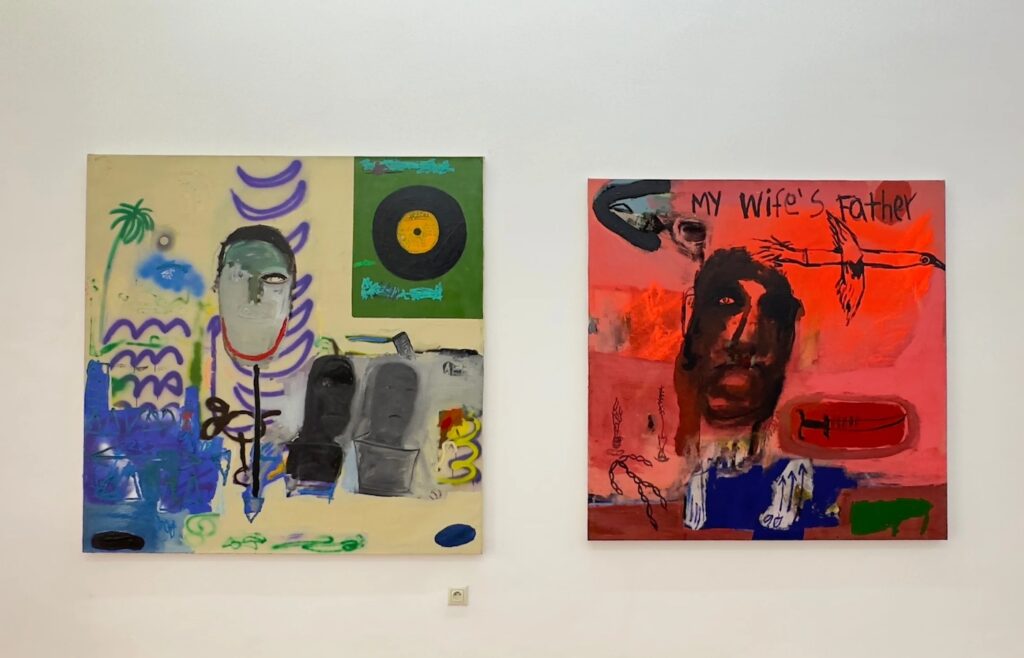BWO Gallery, Douala, Cameroon
06 Mar 2025 - 26 Apr 2025

Emanuel Tegene, Until the Mockingbird Stops to Sing, installation view, 2025.
In the novel To Kill a Mockingbird, author Harper Lee wrote, Mockingbirds don’t do one thing but make music for us to enjoy. They don’t eat up people’s gardens, don’t nest in corncribs, they don’t do one thing but sing their hearts out for us. That’s why it’s a sin to kill a mockingbird. In literature, the bird is often a symbol of innocence, resilience, and the overlooked—a creature that exists not to dominate, but to bear witness.
In this exhibition, the mockingbird serves as a metaphor for Tegene’s approach to painting, where observation is never passive, and repetition becomes a means of resistance. The mockingbird does more than sing; it mimics, it challenges, it warns. Tegene’s paintings, layered with acrylic spray, oil stick and restless brushwork, explore the dynamics of power—how it is performed, inherited, and ultimately disrupted. His repeated use of arrows that never land, symbols that refuse to settle, and markings that feel more like incantations than decoration suggests a world where nothing is fixed—where meaning is continuously negotiated, and memory, like paint, is built up and scraped away in equal measure. His figures navigate influence—whether in politics, relationships, or the subtle performances of power that shape everyday life. In this world, silence is not an absence, but a force to be reckoned with.
Until the Mockingbird Stops to Sing is a testament to both the expressiveness and urgency of Emanuel Tegene’s practice—through a body of work created between 2022 and 2025 that, like the mockingbird itself, observes, repeats, and resists. Rooted in the raw energy of Neo-Expressionism, Tegene’s paintings confront the tensions between power and vulnerability, presence and erasure, history and its echoes. His defiant use of color—electric blues, deep crimsons, bruised yellows—does not merely describe but disrupts, recalling the unrestrained dynamism of Jean-Michel Basquiat, yet grounding itself in a distinctly Ethiopian visual language. Like Basquiat, Tegene builds a world of fractured narratives and restless mark-making, where symbols become both personal hieroglyphs and cultural signifiers. Birds, arrows, moons, and triangular forms recur like fragments of an unfinished script, shaping a visual lexicon that is part memory, part instinct, part prophecy. His canvases are maps of influence and resistance, where meaning is never static, where symbols serve as both markers and warnings—guiding, obstructing, and questioning the very act of seeing.
Tegene’s time is split between Addis Ababa—his primary base—and other African cities like Abidjan and Dakar, continuously shaping his work and deepening his understanding of the complex governance realities affecting development across the continent. His paintings, including African Leaders, Famous Horny, Karma, and The North Face, offer critical examinations of contemporary African politics and society. The North Face is a striking reflection on the contradictions embedded in place and memory. The painting’s bright background, easily associated with softness and innocence, becomes an unsettling backdrop for a subject charged with tension—the ongoing struggles in Ethiopia’s northern region. This part of the country, celebrated for its historical and cultural significance, is both a symbol of national pride and a terrain marked by war, displacement, and deep political fractures. The title itself functions as a double entendre, referencing both a global brand and the geopolitical weight of the North as a site of admiration and devastation.
Like Picasso’s Guernica (1937), which abstracted the violence of the Spanish Civil War into a fragmented composition, The North Face fuses figuration and abstraction to reflect a reality that is layered, unresolved, and fraught with opposing forces. It does not dwell solely on destruction but acknowledges resilience and the lasting imprint of history. Tegene’s use of color, form, and metaphor creates a paradox—playful yet unsettling, familiar yet elusive—urging viewers to look beyond the surface and confront the ways history continues to shape the present.
For Emanuel Tegene, power does not reside only in systems or symbols; it is embedded in the most intimate of spaces—marriage, inheritance, devotion. His paintings, particularly My Wife’s Father and The Heir’s Wife, interrogate the weight of expectation within family structures, where love and obligation are often indistinguishable. The Heir’s Wife presents a face etched into a coin, that evokes the permanence of lineage, its spectral portrait emerging from the worn imprint of a coin—a symbol of both material wealth, greed and the weight of legacy.
Yet, Tegene is just as attuned to tenderness as he is to critique. In I Love U, a phonograph record —marked with those simple, universal words—rests against a green backdrop like a postage stamp— an emblem of affection, addressed to the past and the present alike. The work carries the echo of a private exchange between the artist and his wife, Melon, yet its fractured forms remind us that love, like memory, is constructed in layers. Tegene’s approach to painting—accumulative, textured, revealing—mirrors the way intimacy unfolds over time, shaped by presence and absence, by words said and left unsaid. Even here, where history lingers, the possibility of connection remains.
Tegene’s paintings do not impose conclusions; instead, they invite a reckoning. His compositions pulse with the tension of what is seen and unseen, spoken and withheld, offering spaces where meaning remains in flux. Like the mockingbird, his practice moves between personal and collective memory, between critique and tenderness. His figures emerge and dissolve, symbols echo and distort, and color is both a beacon and a disruption, holding within it the weight of history and the possibility of renewal.
Until the Mockingbird Stops to Sing is not about silence, but about the responsibility of listening. Tegene does not dictate meaning—he offers an opening. It is the viewer who must step in, to witness, to question, to recognize the echoes that persist. The question, then, is not just when the mockingbird will stop singing—but who is listening while it does.
– Curatorial text by Brice Arsène Yonkeu